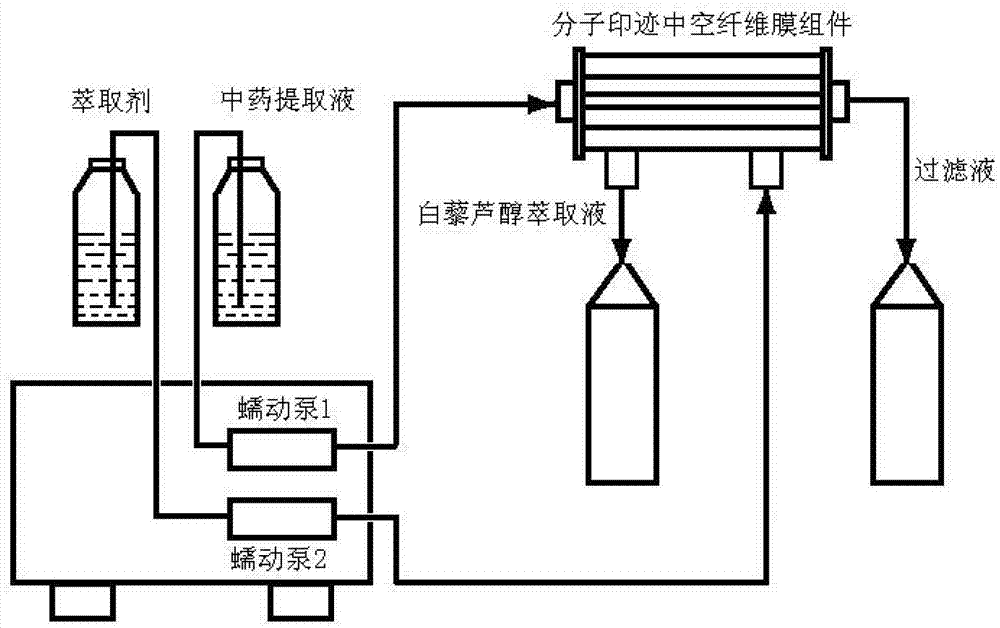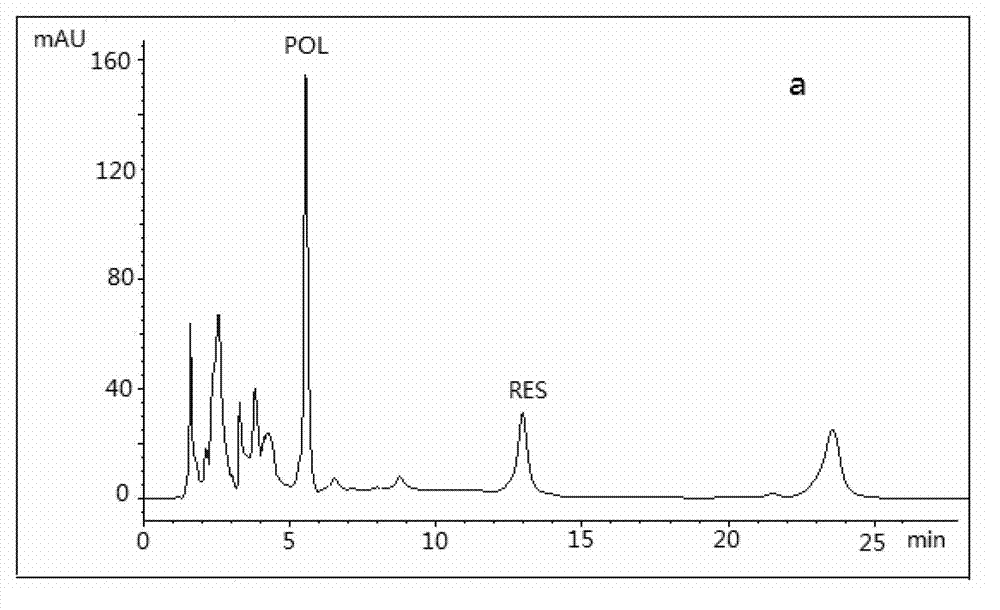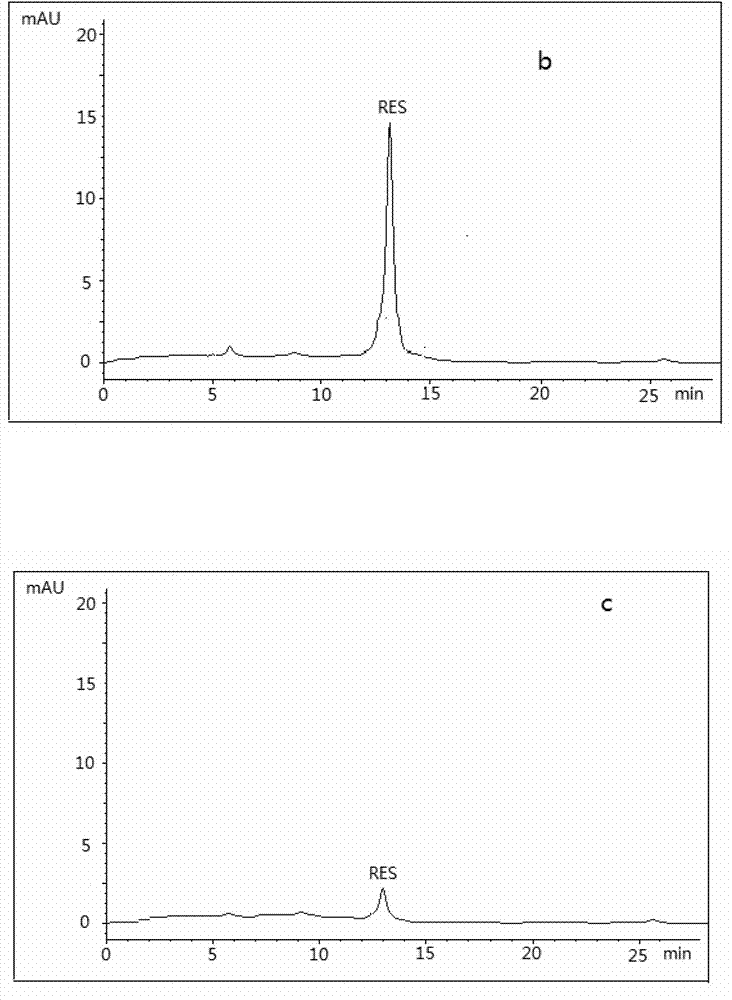Method for separating trans-resveratrol from giant knotweed
A technology of resveratrol and Polygonum cuspidatum, applied in the field of compound trans-resveratrol, can solve the problems that have not been reported on the separation of active components of molecularly imprinted hollow fiber membranes, and achieve the effect of separation of selective permeability
- Summary
- Abstract
- Description
- Claims
- Application Information
AI Technical Summary
Problems solved by technology
Method used
Image
Examples
example 1
[0030] Example 1 (Preparation of trans-resveratrol molecularly imprinted polymer membrane)
[0031] (1) Dissolve 0.038g trans-resveratrol and 0.071g acrylamide in 1ml acetonitrile, overnight at 4°C, then add 1g ethylene glycol dimethacrylate and 0.01g azobisisobutyronitrile , feed nitrogen to deoxygenate to obtain monomer solution;
[0032] (2) Soak the polyvinylidene fluoride (PVDF) film in the monomer solution for 1 hour, then take it out and place it between two glass slides, and place it in a vacuum drying oven at a vacuum degree of -0.09 to -0.005 Under the conditions of MPa and temperature of 52°C, the polymerization reaction was carried out for 48 hours to obtain the precursor of the resveratrol molecularly imprinted polymer membrane; the polyvinylidene fluoride membrane has the following performance parameters: the membrane pore diameter is 0.2-0.45 μm, and 1000-1400μm, wall thickness 200-300μm, porosity 80-90%, pure water flux 200-300L / m 2 .h;
[0033] (3) Wash the...
example 2
[0035] Example 2 (separation of trans-resveratrol)
[0036] 1. Extraction of trans-resveratrol
[0037] (1) Take 1g of Polygonum cuspidatum, add 50ml of 95% ethanol to reflux and extract for 2 hours, filter, concentrate the filtrate under reduced pressure to extract, disperse in water, apply AB-8 macroporous adsorption resin, and elute with water and 30% ethanol-water in sequence , collect 30% ethanol-water eluate, concentrate under reduced pressure, and dry to obtain alcohol extract of Polygonum cuspidatum;
[0038] (2) Dissolve the alcoholic extract of Polygonum cuspidatum in methanol, so that the concentration of Polygonum cuspidatum extract in the solution is 50 μg / ml to obtain a sample solution;
[0039] (3) Pump the sample solution and methanol into figure 1 The membrane separator shown, and makes the sample solution flow in the membrane tube at a speed of 0.5ml per minute, and the extractant flows in reverse at a speed of 0.5ml per minute outside the membrane tube; wh...
example 3
[0055] Example 3 (separation of trans-resveratrol)
[0056] (1) Take 1g of Polygonum cuspidatum and add 40ml of 80% ethanol to reflux to extract for 2.5h, filter, concentrate the filtrate under reduced pressure to extract, disperse in water, and wash with water and 30% ethanol-water successively on AB-8 macroporous adsorption resin , collect 30% ethanol-water eluate, concentrate under reduced pressure, and dry to obtain alcohol extract of Polygonum cuspidatum;
[0057] (2) Dissolve the alcoholic extract of Polygonum cuspidatum in water so that the concentration of Polygonum cuspidatum extract in the solution is 20 μg / ml to obtain a sample solution;
[0058] (3) Pump the sample solution and ethanol into figure 2 The membrane separator shown, and makes the sample solution flow in the membrane tube at a speed of 0.8ml per minute, and the extractant flows in reverse at a speed of 0.8ml per minute outside the membrane tube; when the inner and outer phases of the membrane tube are...
PUM
| Property | Measurement | Unit |
|---|---|---|
| Membrane pore size | aaaaa | aaaaa |
| Outer diameter | aaaaa | aaaaa |
| Wall thickness | aaaaa | aaaaa |
Abstract
Description
Claims
Application Information
 Login to View More
Login to View More - R&D
- Intellectual Property
- Life Sciences
- Materials
- Tech Scout
- Unparalleled Data Quality
- Higher Quality Content
- 60% Fewer Hallucinations
Browse by: Latest US Patents, China's latest patents, Technical Efficacy Thesaurus, Application Domain, Technology Topic, Popular Technical Reports.
© 2025 PatSnap. All rights reserved.Legal|Privacy policy|Modern Slavery Act Transparency Statement|Sitemap|About US| Contact US: help@patsnap.com



